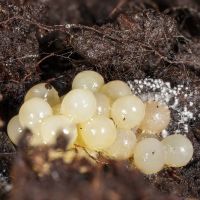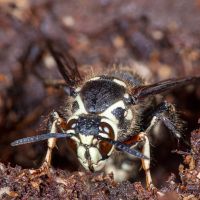Finding Salamanders
7/25/2020
So this article was meant for a few months back, but apparently I was intent on covering junk food and zapping myself with depression-era medical devices. But as I increasingly want to start working on Halloween things, I figure I may as well catch up on some early Spring topics that I can pass off during summer.

So back in April, we found that there was a bit of time on our hands due to [current events]. With nothing open, the wide outdoors beckoned. The powers that be tried to ban the outdoors too, but the rebel spirit was strong, so off we went. It was still early though, so the vibrant wildlife of summer hadn't really hit yet. Despite this, you just had to do a little digging…literally.
There's a fair amount that hibernate or simply do their business under rocks and logs, so the normal nature walk includes lots of flipping things over to see what is hiding. There's always the stray centipede, millipede, ant, or endless pillbugs, but we had a goal. That goal was to try and find all four types of salamanders that we knew were in the forest. Now I know there are some others, but these choices were based on what was found on a few prior trips. I usually just try to see what I can find on any given trip, but setting a plan seemed like a challenge.

 So the four of interest are the Redbacked Salamander (Figure 1) in its normal Redback phase. There's also a dusty grey version (above) called the Leadback phase. It is technically the same species but lacks the red stripe. They inhabit the same locations, and at times you can find hybrids due to the more progressive ones interbreeding. I was somewhat confused when I found these at first since most of the online guides for our area only showed the Redback phase. I thought it was the more endangered Johnson's Salamander, but no such luck with that rarity.
So the four of interest are the Redbacked Salamander (Figure 1) in its normal Redback phase. There's also a dusty grey version (above) called the Leadback phase. It is technically the same species but lacks the red stripe. They inhabit the same locations, and at times you can find hybrids due to the more progressive ones interbreeding. I was somewhat confused when I found these at first since most of the online guides for our area only showed the Redback phase. I thought it was the more endangered Johnson's Salamander, but no such luck with that rarity.
Redback's are generally one of the most common amphibians in the local forests. Unlike most salamanders, they don't require an active water source and don't lay eggs in ponds, but rather under logs where the humidity remains somewhat constant. During rain storms, they are able to move about more freely, but otherwise require the subsurface world of leaflitter.

 Also in this area were plenty of bald-faced hornets. Not buzzing around mind you, but under the logs with everything else this time of year. I had known previously that hornets, yellow-jackets, and paper wasps generally have one dominant female that survives the prior season and digs into an old log to over-winter. Then when the season is right, they emerge and start building a nest to lay some eggs. The first hatchlings are all female and help continue building the nest out and finding food for the larvae. The adults are actually herbivores, but they still hunt so they can feed the larval stages. Eventually later in the season, males emerge so the future dominant female can have viable eggs for the upcoming year. Anyhow, I had read about all this, but never stumbled on a hibernating example. They weren't really aggressive as most were sluggish from the cooler temperatures, and since the entire brood is dependent on their survival, they're not going to risk venturing out to randomly sting you. Emerging too early will create an inhospitable environment for the larvae, so best to leave them in the logs.
Also in this area were plenty of bald-faced hornets. Not buzzing around mind you, but under the logs with everything else this time of year. I had known previously that hornets, yellow-jackets, and paper wasps generally have one dominant female that survives the prior season and digs into an old log to over-winter. Then when the season is right, they emerge and start building a nest to lay some eggs. The first hatchlings are all female and help continue building the nest out and finding food for the larvae. The adults are actually herbivores, but they still hunt so they can feed the larval stages. Eventually later in the season, males emerge so the future dominant female can have viable eggs for the upcoming year. Anyhow, I had read about all this, but never stumbled on a hibernating example. They weren't really aggressive as most were sluggish from the cooler temperatures, and since the entire brood is dependent on their survival, they're not going to risk venturing out to randomly sting you. Emerging too early will create an inhospitable environment for the larvae, so best to leave them in the logs.

Naturally the Redback was the easiest find, since it is pervasive and pretty much everywhere. The Leadback isn't as common, but you stumble upon a few without much issue. Next up was the Spotted Salamander. We had randomly found one back in March, so on a whim, we traveled out to one of the lesser trails that lead to the general area. As luck would have it, under the very same log the exact Salamander was still hanging out. Easy enough. These have vibrant yellow spots, and you'd think they may be poisonous. Truth be told, I don't know. I didn't attempt to eat it.

With one left to go, I was getting a little nervous about finding the Four-toed Salamander. I knew they were around, and I figured the spotted would be the hardest one if I hadn't found the very same specimen from a month prior. I figured we probably had to head closer to an active water source since they do need that for eggs, unlike the Redbacks. So in a dual mission to find them, as well as just find the path to leave, I knew there was a stream/pond on the way. The dorsal (top) of the Four-toed looks a lot like the Redback except the reddish color is more on the tail, and they have a ribbed appearance for your viewing pleasure. However their ventral (bottom) side is pure white with black speckling. Right before the final path out, I lifted a log and saw the telltale sign of one flipped over. Rest assured, that picture above isn't a dead salamander. They're just cold and don't move too much.
So that's about it. Probably nothing you cared to hear about, but I was on a roll, and wanted to get another article out this month before I start posting pumpkin pictures and getting all basic on you.
